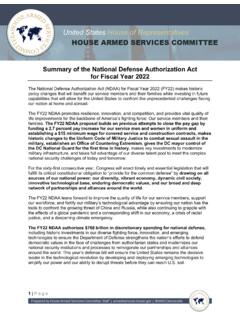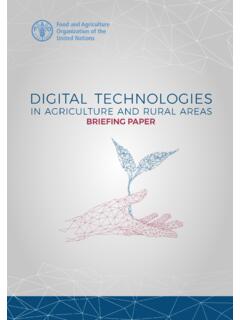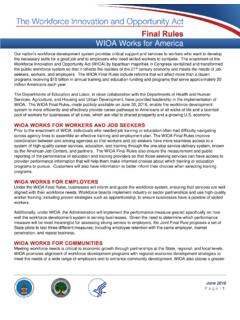Transcription of Social Capital: Measurement and Consequences Robert Putnam
1 1 Social capital : Measurement and ConsequencesRobert Putnam1 This paper starts with a discussion of definitions of Social capital , then turns toissues in Measurement , and finally, presents some evidence on the Consequences of socialcapital. In the last five years, I have been working exclusively on some specific andperhaps unique problems about Social capital in the United States, so all of my examplesare going to be drawn from the United States experience. I don t want to be interpreted assaying these trends are common to all OECD countries. It is just that the United Stateshas been the main focus of my research for the past five are, among those of us who work in the area, some marginal differences interms of exactly how we would define Social capital , but Michael Woolcock correctlysays in his paper that among the people who are working in this field, there has been avisible convergence, definitionally, toward something like the definition he offers.
2 Thecentral idea of Social capital , in my view, is that networks and the associated norms ofreciprocity have value. They have value for the people who are in them, and they have, atleast in some instances, demonstrable externalities, so that there are both public andprivate faces of Social capital . I am focussing largely on the external returns, the publicreturns to Social capital , but I think that is not at all inconsistent with the idea that thereare also private returns. The same is no doubt true in the area of human capital , thereare simultaneously public and private the great debate of the two Cambridges about " capital ", the focus of much ofthe discussion was on whether physical capital was homogeneous enough to besusceptible to aggregate Measurement .
3 There is room for similar debates about humanand Social capital . Obviously there are many different forms of physical capital . Forinstance, both an egg-beater and an aircraft carrier enter into the American nationalaccounts as little bits of physical capital , and yet they are not interchangeable. Try fixingyour morning omelette with an aircraft carrier, or try attacking the Serbs with an egg-beater. The same thing is true about Social capital . Social capital is certainly far fromhomogeneous. 1 Kennedy School of Government, Harvard are some forms of Social capital that are good for some things and not forothers. Now, it is not so easy to see yet exactly how we should add up all those forms inthe same way that, I gather, it was initially not easy to see how we were going to add upall those different forms of physical capital .
4 Accepting that there is no single form ofsocial capital , we need to think about the multiple dimensions of Social capital . High onthe research priority list in the area of Social capital , as far as I am concerned, isdeveloping the theoretically coherent and empirically valid typologies or dimensionsalong which Social capital should vary. I will give some examples of how Social capitalvaries, but I don t think we are anywhere near yet a kind of canonical account of thedimensions of Social forms of Social capital are highly formal, like a PTA (Parent-TeacherAssociation) organisation or a national organisation of any sort, or a labour union,formally organised with a chairman and a president, and membership dues and so forms of Social capital , like the group of people who gather at the bar everyThursday evening, are highly informal.
5 And yet, both of those constitute networks inwhich there can easily develop reciprocity, and in which there can be gains. Some formsof Social capital are densely interlaced, like a group of steelworkers who work togetherevery day at the factory, go to Catholic Church every Sunday, and go out bowling onSaturday. That is a very dense, interconnected, multiplex form of Social capital . Thereare also very thin, almost invisible forms of Social capital , meaning networks and theassociated norms of reciprocity, like the nodding acquaintance you have with the personyou occasionally see at the supermarket, while waiting in t be too dismissive of very casual forms of Social connection, because therehas been good experimental evidence that if you nod to people in the hall, they are morelikely to come to your aid if you should have a fit or have a heart attack, than if you don tnod to them, even if you don t otherwise know them.
6 Merely nodding to someone in thehall generates visible, measurable forms of reciprocity. So there are, as I say, these veryevanescent forms and also quite regular forms of Social capital , both formal and agree with Michael Woolcock that one of the most important distinctions is betweenbridging and bonding. And I certainly agree with him that not all Social capital has goodconsequences for every was called most vividly to my attention in a book review that appeared on thefront page of the New York Times several years ago, written by a former student of wasn t reviewing a book of mine, but somebody else s. In his review, he calledattention to the fact that Tim McVeigh cooked up the Oklahoma City bombing in abowling alley in Oklahoma City.
7 The reviewer then juxtaposed this with my articlewritten several years ago, called Bowling Alone ( Putnam 1995), in which I calledattention to the fact that Americans were no longer bowling in leagues. The last line ofthe New York Times review is "we all would have been better off if Tim McVeigh hadgone bowling alone." The network of people who formed this conspiracy was indeedsocial capital it enabled Tim McVeigh to do things he could not otherwise have , this was clearly an example of Social capital (involving as it did, bothreciprocity and trust) that was put to genuinely destructive ends. In short, it had negativeexternalities. Of course, this possibility is not unique to Social capital . In that samebombing, there were bits of physical capital that were put to destructive ends, the truckthat was blown up, and there were bits of human capital that were put to destructive ends,the bomb-making expertise.
8 What I wish to emphasize is that all forms of Social capital ,indeed any form of capital , can be used to ends that are in some instances now turn to address issues of Measurement , especially Measurement of long-runtrends, over the course of the twentieth century, in Social capital in the United States. Formany Americans that is an interesting question. In Putnam (1995) I conjectured that thelong-run trends, at least the recent trends, in Social capital in the United States weredown. In that article I provided preliminary evidence that showed, at least by somemeasures, that membership in organisations was down. My recent book ( Putnam 2000)looks in much more detail at the question of trends in Social capital in the United the course of doing research for that book, I faced the same problem that students ofglobal warming face.
9 That is, you know exactly what evidence you would have likedpeople to have collected 200 years ago so that you could now tell whether there have beensubsequent trends in warming, but you are stuck with what data happened to have beengathered then. The solution that the global warming people use is to triangulate amongdifferent sources of evidence, any one of which is imperfect. However, if you get thesame basic story from ice cores in Greenland, from tree rings in the Southwest of theUnited States, and from the temperature records of the British Admiralty, even though4any of those measures is subject to some error and none of them is exactly the measureyou would want, concordance among different sources of evidence makes more plausiblethe claim that there has been an upturn in average global want to show you very briefly the kinds of evidence that I have brought to bearon the question of long-run trends in the United States in Social capital , and I want tobegin with the simplest kind of evidence that I used in my earlier article.
10 I now show thisevidence by means of market share measures for many major civic organisations inAmerican life. What fraction of all Jewish women in America belongs to Hadassah?What fraction of catholic men belongs to the Knights of Columbus? What fraction of alladult men belongs to one of the animal clubs , that is, men s organisations? (Animalclubs is a technical term. I only realised when I began doing this research that all men sclubs in America are named for animals: the Lions club, the Moose club, the Elks club,the Eagles club, and so on.)So for all these organisations we gathered market share data, as well as for manyother organisations. What fraction of rural kids belongs to the 4-H? What fraction ofgirls belongs to the girl-scouts?















